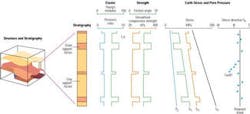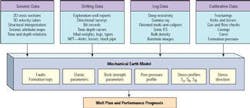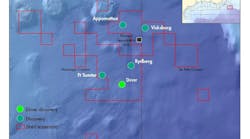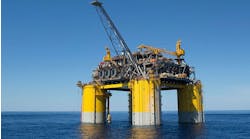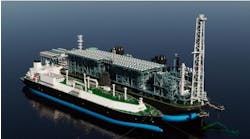A process-driven approach to drilling deep-water wells has been found to minimize surprises, increase drilling efficiency, reduce non-productive time, and lower costs.
Integrated planning across disciplines is the key to the collaborative process, comparing a plan with new well measurements, updating it using these measurements, and quickly responding to deviations (surprises) from the plan. After the well is drilled, a careful review captures lessons learned for future deepwater projects.
Process-driven approach
Lack of detailed planning before drilling can result in unanticipated incidents, or "surprises," while drilling. Surprises encountered during drilling might necessitate well construction remedies like additional casing strings that otherwise could have been eliminated with proper planning. Materials such as equipment or drilling fluids that are lost during deepwater drilling operations could incur drilling expenditures unnecessarily, which in turn raise overall development costs and negatively impact project economics.
Time losses, or non-productive time (NPT), also can translate into cost overruns. During drilling, time is considered non-productive when used to correct problems rather than execute the well plan. Time spent searching for and implementing solutions to unexpected events impedes the continuity of the drilling process and increases costs.
A detailed plan addresses possible variables that might be encountered, which helps pinpoint causes for possible incidents or events. Probable causes of an event are outlined and appropriate actions or contingencies that must be taken should one occur during drilling are specified, simplifying onsite decision-making. Therefore, the plan should include strategies for solving potential problems under abnormal circumstances, in addition to the procedures to follow under normal operating conditions.
Successful deepwater drilling requires not only developing a project-specific plan, but also continually updating it as new knowledge is gained. Managing geologic risk, avoiding drilling problems, and eliminating surprises ensures a continuous drilling process, minimal losses and lower finding and development costs for deepwater plays.
Schlumberger and BP have developed a solution to meet the technical and economic challenges of deepwater and other high-risk projects. The solution is known as No Drilling Surprises (NDS). The process is executed through the Performance Through Risk Management (PERFORM) service at the wellsite, and supported by an onshore technical team. The process steps include:
- Developing and executing a living well plan
- Understanding and developing contingencies for potential hazards
- Anticipating these hazards using the living well plan
- Making real-time comparisons of planned vs. actual occurrences
- Capturing lessons learned in the review process.
The process can be broken down into three phases: planning during the pre-drill phase, executing during the while-drilling phase, and reviewing during the post-job phase.
Pre-drill plan
The pre-drill planning phase begins when a team of geomechanics and drilling engineers conduct a pre-drill risk assessment. A mechanical earth model is constructed, which is used to create an optimal drilling plan.
A mechanical earth model is a computer-based representation of the stress and rock mechanics of a specific stratigraphic section in a field or basin. Local stratigraphy and 3D seismic images are used to link it to the related geologic structure. An earth model consists of formation tops, faults, elastic parameters, rock strength information, pore pressure profiles and stress directions, and variations with depth.
Once a reservoir target is selected, information from the earth model can be extracted to create a pre-spud well plan. Mapping the well path requires in-depth knowledge of stress parameters, rock properties, and how the drilling process will interact with them. All of these are obtained from the earth model. The optimal well plan must agree with trajectory goals that optimize the drilling process.
While-drilling execution
At the rig, the well is drilled according to the well plan. Subsurface and engineering data are acquired while drilling to help optimize the drilling process. The information is collected, interpreted, and incorporated back into the drilling process, the well plan, or the earth model itself.
The onsite engineer compares real-time data to the expected properties, such as pore pressure. Well conditions are evaluated continually to identify any new hazards that may have developed. Drilling risks also are re-evaluated and new risk assessments are formulated. By continually modifying and updating the well plan, it becomes a living document, rather than a static one.
The onsite engineer communicates frequently with the onshore geoscience and engineering team to evaluate departures from the plan, identify any new hazards that may have developed, and generate the updated risk assessment. Secure communications among all team members, onsite and office-based, ensure that informed, timely decisions can be made.
To aid communication and decision-making, the onsite engineer uses a report, which relays the conditions and potential hazards ahead and provides methods to detect and manage them.
If drilling is not proceeding as expected, the appropriate contingency is identified and followed. If a suitable contingency is not found, an action plan is developed through careful analysis. A plot is used to update the drill map while drilling. It captures any trajectory changes, drilling effectiveness parameters, near-missed hazards and, if necessary, events or losses.
Post-job review
Prior to beginning a future comparable project, the series of decisions and associated actions undertaken during the planning and execution phases of the current project are analyzed. The current project's degree of success or failure is determined by the quality of those decisions.
Project efficiency and profitability also are evaluated. From the review process, lessons learned are captured and then applied to analogous projects undertaken in the future.
Deepwater driver
When drilling in challenging environments, the use of this systematic approach is even more critical. For challenging projects, the planning and continual updating approach focuses mainly on wellbore-pressure management and wellbore-stability management practices. Specifically, when drilling deepwater wells, wellbore pressures must be managed to keep equivalent static density (ESD) and equivalent circulating density (ECD) within narrow pressure ranges.
Since drilling a hydraulically stable hole can be achieved only by maintaining mud weights within narrow pore-fracture pressure margins, safe well design and control practices require advance knowledge of pore pressures and fracture gradients. Therefore, effective pressure management begins with a representative earth model that provides accurate pore pressure predictions.
During the pre-drill planning phase, pore pressures can be predicted using information from nearby wells. This might include drilling experience, seismic data, and sonic and resistivity measurements. Predictions can be updated and enhanced during drilling using calibration data from drilling observations, look-ahead vertical seismic profiles, and while-drilling formation measurements.
As a well is drilled, actual pore pressures and annular pressures are measured and software for managing the ECD of the mud are employed. Wellbore pressures are managed to keep ESD and ECD within the pore-fracture pressure window. The real-time measurements and predictive ECD tools also are used to continually update the earth model and well plan.
Applications
Applications of this process include:
- In the ultradeep Gulf of Mexico, when these practices were applied in a well being drilled in water depths exceeding 6,000 ft, two casing strings and more than two months of rig time were eliminated, resulting in an estimated $15-million cost savings. Moreover, there were no kicks, losses, or hole cleaning problems on this well.
- In a deepwater well off South America, wellbore pressure management practices helped avoid problems when a deviation from the original plan was noted and acted upon. The onsite engineer interpreted a pore pressure increase based on real-time data, although the pre-drill plan predicted decreasing pressure. Real-time collaboration confirmed that the pore pressure was in fact increasing. The team agreed to check the flow every half stand, rather than every stand. Shortly thereafter, during a half-stand flow check, a small kick was encountered. Had the entire stand been drilled, the kick would have been much larger. The kick was circulated out safely, and the mechanical earth model and plan were updated.
Initially, the NDS solution and the information derived from it focused on well construction optimization, primarily during the drilling phase. Its future direction is to integrate information gathered while drilling with subsequent well construction activities.

